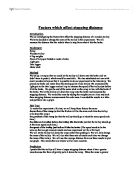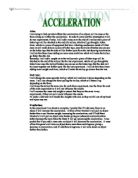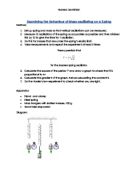Do things have to be scientifically proven to be true?
Do things have to be scientifically proven to be true? Usually things do have to be scientifically proven to become true. For instance in a law suit in which the court is trying to determine if a certain man is a father of a baby, just as an example, a scientific process must take place in which the DNA of the father and the baby are tested for similarities. Then the truth will appear once the results from a genetic laboratory arrive. Another example is if they want to find the murderer of a crime and there was blood of the murderer at the crime scene they could also scientifically check if the true murderer is the same as the person accused. Other than lawsuits, things also have to be scientifically proven true to be accepted by the society. For instance global warming, if someone simply states that global warming is amongst us the fact that people are going to find it true is very slim. However if that same person backed his claim scientifically with evidence, such as stating that the Glaciers are melting, plants and animals are being forced from their habitat, and the number of severe storms and droughts is increasing, then his claim would be accepted. However, there is the argument that people thought that their theories were the truth however now as more advancements in science are being made we realize that these theories are incorrect. For instance, in the late 1800's
Factors which affect stopping distance
Factors which affect stopping distance Introduction We are investigating the factors that affect the stopping distance of a wooden trolley. We have decided to change the mass of the trolley in this experiment. We will measure the distance that the vehicle takes to stop from when it hits the brake. Equipment Ramp Wooden trolley 4 1kg weights Piece of A4 paper folded to make a brake Light gate Data logger Meter stick Method We set up a ramp so that we could let the trolley roll down onto the brake and we didn't have to push it, which would be unreliable. We also substituted real cars with small wooden trolleys so that it is possible to do our experiment in the laboratory. We placed our brake one meter from the starting point of our trolley. We connected the light gate to the data logger and set it up to measure the speed of the trolley just before it hit the brake. We put the end of the meter stick on the ramp in line with the back of the brake. We let the trolley roll down the ramp onto the brake and measured the stopping distance. We varied the mass by adding the weights one at a time and took three stopping distance measurements for each mass. I recorded the results in a table and put them into a graph. Fair Test To make this experiment a fair test, we will keep these factors the same: the surface of the ramp (so that the friction will be the same each
To get any object to move in a circle you have to apply a force to it
Centripetal force of a rubber bung Aim : To get any object to move in a circle you have to apply a force to it. Methods : With your experiment you don't mention anything about controlling or measuring the force. All you have measured is the (average) period of the object moving in a circle. From this you can calculate the average speed and acceleration. To turn this into an investigation you would need to measure the force pulling the bung into the circular path. i.e. the tension in the string. At the moment, if you put more effort in the bung will go faster, even if you don't change the radius of the circle, or the mass of the bung. One way to do this would be to include a spring of suitable strength into the string and you could possible measure the extension of the spring as you twirl it around to estimate the force. Another method I've seen used is to have the string pass through a tube. On the bottom end of the string you attach a weight. You twirl the bung around above your head whilst holding the tube until the forces are balanced. If you spin it too slowly the weight drops down, if you go too fast it rises up. You need to adjust the speed of spinning until the weight balances at the correct point. Results: There is a fairly simple formula for cicular motion. F = (m X v2) / r F = force (Newton) m = mass of bung (kg) v = speed of bung (m/s) r =
Investigating what effects the acceleration of an object; will its mass or the force acting on it effect the acceleration.
Aim: I am trying to find out what effects the acceleration of an object; will its mass or the force acting on it effect the acceleration. In order to carry out this investigation I will do two experiments. Firstly, I will add a mass on to the end of a trolley and a piece of ticker tape will be attached to the end of a trolley, which will go through a ticker timer, which is a piece of equipment that has a vibrating mechanism inside of it that once on will make dots on a piece of ticker tape, once the trolley finishes you can see on the ticker tape that the dots will be farther apart from the last showing acceleration. I will do this three times adding on more mass each time which will make the trolley go faster than the last. Secondly, I will add a weight on to the trolley and a piece of ticker tape will be attached to the end of the trolley like the last experiment, which will go through the ticker timer once the trolley finishes you can see on the ticker tape that the dots will be closer together not farther apart like the last experiment. I will do this three times adding more weight each time, which will make the trolley go slower than the last. Fair test: I will change the mass upon the trolley, which will and slow it down depending on the mass. I will also change the force pulling the trolley, which will fasten it up depending on the force. I will keep the
Compulsory National Service in S.A.
Compulsory National Service in S.A. In my argument whether conscription in South Africa should be brought back or not. I will discuss both sides of the argument. To start off I will look at the positive side first. If people were forced to go to the Army or Navy or Air Force the rate of unemployment will drop dramatically helping people get off the streets and get involved in helping their country. There are many people doing nothing all day long! Education and tertiary services could be furthered by National Forces. Crime forces could be trained up through the army and then fill in the gap left in the country by our depleted police force. By increasing our criminal forces, things like Nature Conservation can increase. One of the strongest points is that should we ever be in a war or conflict area we would need a far bigger trained force than we have now and by the Government forcing people to go the National Forces this could increase the trained people needed for combat. Our Air Force at the moment is totally depleted and this would be a good reason to train pilots. The 'Arms Deal' that has caused such a debate and problem in our country would then maybe seem to have a reason and a place to deploy all the armament that has been bought. We as young men don't always have a clean cut idea of what we want to do after we finish school, this could fill in the gap year and
Radiotherapy is the use of high energy x-rays and similar rays such as electrons to treat diseases.
Radiotherapy is the use of high energy x-rays and similar rays such as electrons to treat diseases. Radiation has been used a lot in medicine whether it is to help with diagnosis by taking pictures with x-rays or as a treatment such as radiotherapy. Radiotherapy is a treatment for people with cancer, it can be given within the body as internal therapy or from the outside of the body using x-rays (external therapy). Radiotherapy works by destroying the cancer cells in the treated area. Also normal cells can also be damaged during the treatment but they can usually repair themselves. It can cure some cancer; it also can be used to diminish cancer symptoms. Radiotherapy treatment can also lessen the possibility of cancer coming back subsequent to surgery Radiation therapy kills cancer cells by damaging or destroying their DNA. It also could affect your regular cells in your body. Also, radiation therapy may not destroy or damage a cancer cell right away. They will either damage the cancer cell's DNA or create charged particles that will damage the DNA for them. Linear accelerator A linear accelerator (also called a LINAC) is a piece of equipment most commonly used for external beam radiation treatments for patients with cancer. The linear accelerator can also be used in Stereotactic Radiosurgery comparable to that attained using the gamma knife on targets within the brain.
Examining the Behaviour of Mass oscillating on a Spring
Examining the Behaviour of Mass oscillating on a Spring Method: . Set up spring and mass so that vertical oscillations can be measured. 2. Measure 10 oscillations of the spring as accurately as possible and then divided this by 10 to give the time for 1 oscillation. 3. Do this for masses that are under the spring's elastic limit. 4. Take measurements and repeat the experiment at least 3 times Theory predicts that for the loaded spring oscillator. 5. Calculate the square of the period T² and draw a graph to check that it is proportional to m 6. Calculate the gradient of the graph, hence calculating the constant k 7. Do the Hooke's law experiment to check whether you are right. Apparatus * Stand and clamp * Steel spring * Mass hangers with slotted masses, 100 g * Hand held stopwatch Diagram: st Trial Mass (Kg) Time For 10 Periods (s) Time for 1 Period (s) 0.1 3.81 0.381 0.2 5.56 0.556 0.3 6.88 0.688 0.4 8 0.8 0.5 8.87 0.887 0.6 9.63 0.963 2nd Trial Mass (Kg) Time For 10 Periods (s) Time for 1 Period (s) 0.1 3.63 0.363 0.2 5.79 0.579 0.3 6.81 0.681 0.4 7.84 0.784 0.5 8.72 0.872 0.6 8.81 0.881 3rd Trial Mass (Kg) Time For 10 Periods (s) Time for 1 Period (s) 0.1 3.84 0.384 0.2 5.78 0.578 0.3 6.75 0.675 0.4 7.75 0.775 0.5 8.75 0.875 0.6 9.62 0.962 Average Mass (Kg) Time For 10 Periods (s) Time
Checking Newton’s 2nd law of motion
Checking Newton's 2nd law of motion In this experiment I will make measurements on a two - pulley system and use them to check Newton's 2nd law: 'The rate of momentum of a body Is directly proportional to the external, Resultant force acting upon it. The change in momentum takes place in the Direction of that force. The apparatus is set up as shown in the diagram below: The masses m1 and m2 are initially set at 400 grams each. The ruler is set vertically. I measured and recorded the distance (S). There must be the same friction at the pulleys; in order to comply with this took added 10 grams masses to m1 until the two masses jus begin to move. I recorded the extra masses m0 added, and the total mass M of m1 and m2. I then held m1 by hand, added one 10g mass, and released it. My partner at that exact moment started the stopwatch. When the m1 hit the soft material the stopwatch was stopped. I recorded the time taken in the table below and repeated this a further one more time so I could finally take an average reading. Extra mass added to m1 Time 1 s Time 2 s Mean Time Time² s² /(m Kgs-1 0.020 3.0 4.18 3.59 2.8 50 0.040 .60 2.14 .87 3.49 25 0.060 .62 .45 .53 2.34 6.6 0.080 .19 .30 .24 .53 2.5 0.100 .19 .0 .09 .18 0 On then ext page is the graph that I plotted with t on t on the y- axis against 1/(m on the x- axis. Theory:
The egg drop challenge is not mostly a "shock absorption" exercise; the springiness of the padding around the egg is the determining factor.
Egg Drop Contest Materials List 2 small foam cups 2500 square centimeters of plastic bubble wrap 25 paper tissues 12 cm3 cardboard box Abstract of Physical Principals The egg drop challenge is not mostly a "shock absorption" exercise; the "springiness" of the padding around the egg is the determining factor. A bus without springs is near impossible to drive, while one without shocks feels almost normal until moments when the shocks are needed. What will break the egg is to have a force on the egg greater than the shell can withstand. This can be avoided by distributing the force evenly across the egg's surface. The shell is very strong if the force is well distributed, and very weak if the force is all at one point, or on a small area. You can pierce the egg with a very small force with a needle, yet you can put it between your palms and push with great force without breaking it. If your "padding" is too soft, it will work well until the padding has compressed, and then the egg will experience a large g-force and break. If your padding is too hard, then the egg will break while the padding is being compressed. What is desired is padding that will compress at a rate that gives the egg the longest time to stop. We believe that the best solution is to have increasingly soft padding surrounding the egg in multiple (in our case, 3) layers. Our guess is that firm foam
Newton's Three Laws of Motion
Newton's Three Laws of Motion Isaac Newton was born on Christmas day in 1642, in Lincolnshire, England. Newton attended Trinity College in 1661 and had both his Bachelor of Arts and his Master of Arts by 1669. That same year he became the associate of the French Academy of Sciences. He was elected to Parliament, and then appointed a warden, and finally, President of the Royal Society. Newton was a Master of Science and mathematics. He discovered calculus, before Leibniz' became popular. Perhaps Newton's most popular discovery, though, was gravity. As the story goes, Sir Isaac Newton was resting under a tree one day in his garden, when an apple fell from it and hit him on the head. Thus, he discovered gravity. The earth's gravitational pull pulls objects toward it. However, many people believe that this is only a myth created to simply illustrate Newton's discovery. Along with Newton's many discoveries, the three laws of motion are famous. These include inertia, acceleration, and the idea that for every action, there is an equal and opposite reaction. Inertia is the idea that a body in motion will remain in motion, and a body at rest will remain at rest. For example, if I were to throw a baseball into the air, it would keep going until gravity pulled it back down to earth. However, if I left it sitting on a table, it would lie there until some kind of force were to move it.












